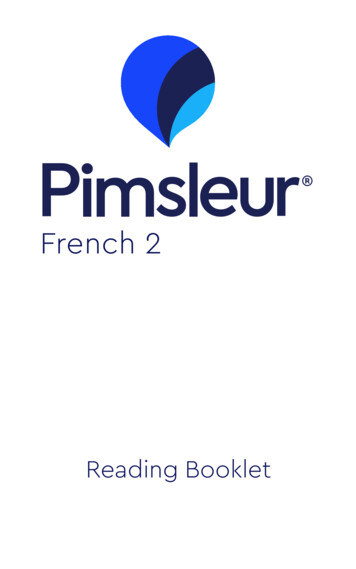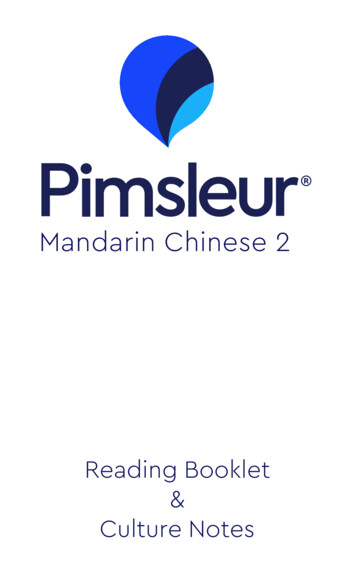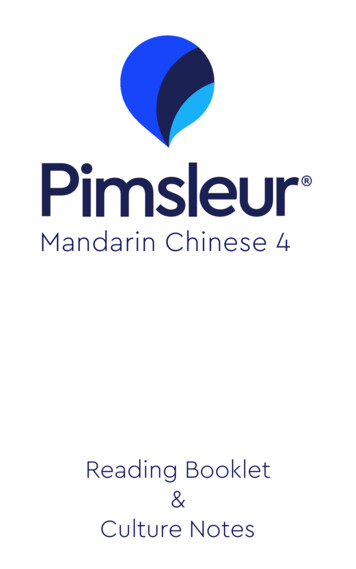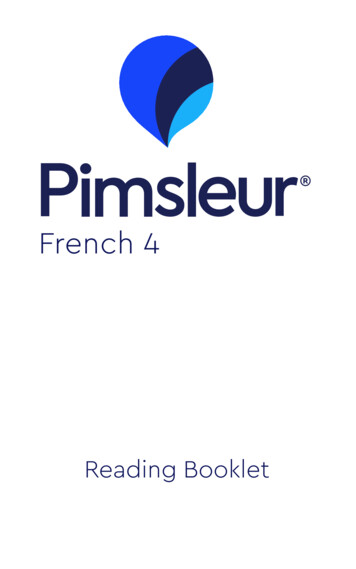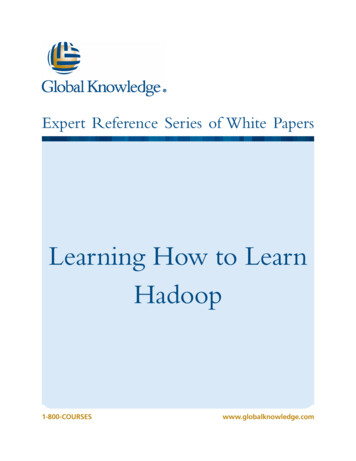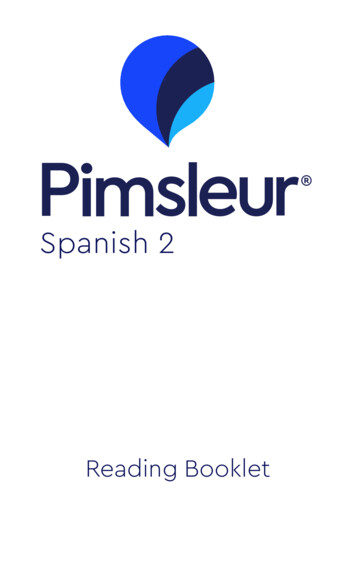
Transcription
Spanish 2Reading Booklet
Spanish 2Travelers should always check withtheir nation's State Department forcurrent advisories on local conditionsbefore traveling abroad.Booklet Design: Maia KennedyFourth Edition and ‰ Recorded Program 2020 Simon & Schuster, Inc. Reading Booklet 2020 Simon & Schuster, Inc.Pimsleur is an imprint of Simon & Schuster Audio,a division of Simon & Schuster, Inc. Mfg. in USA.All rights reserved.ii
Spanish 2ACKNOWLEDGMENTSVoicesEnglish-Speaking Instructor. . . . . . . . . . . . . . . . . Ray BrownSpanish-Speaking Instructor . . . . . . . . . . . . . César GuerraFemale Spanish Speaker . . . . . . . . . . . . . Monica CanavanMale Spanish Speaker . . . . . . . . . . . . . . . . . . . . . . . . Luis CortesCourse WritersMonica Canavan Emily TaylorEditorsBerit S. Ahmad Joan SchoellnerMary E. GreenReviewerSantiago CovarrubiasExecutive ProducerMary E. GreenProducer & DirectorSarah H. McInnisRecording EngineerPeter S. TurpinSimon & Schuster Studios, Concord, MAiii
Spanish 2Table of ContentsIntroduction . . . . . . . . . . . . . . . . . . . . . . . . . . . . . . 1Lesson One . . . . . . . . . . . . . . . . . . . . . . . . . . . . . . 11Lesson Two . . . . . . . . . . . . . . . . . . . . . . . . . . . . . . . 13Lesson Three . . . . . . . . . . . . . . . . . . . . . . . . . . . . . 15Lesson Four . . . . . . . . . . . . . . . . . . . . . . . . . . . . . . 17Lesson Five . . . . . . . . . . . . . . . . . . . . . . . . . . . . . . . 19Lesson Six . . . . . . . . . . . . . . . . . . . . . . . . . . . . . . . 21Lesson Seven . . . . . . . . . . . . . . . . . . . . . . . . . . . . . 23Lesson Eight . . . . . . . . . . . . . . . . . . . . . . . . . . . . . 25Lesson Nine . . . . . . . . . . . . . . . . . . . . . . . . . . . . . . 27Lesson Ten . . . . . . . . . . . . . . . . . . . . . . . . . . . . . . . 29Lesson Eleven . . . . . . . . . . . . . . . . . . . . . . . . . . . . 31Lesson Twelve . . . . . . . . . . . . . . . . . . . . . . . . . . . . 33Lesson Thirteen . . . . . . . . . . . . . . . . . . . . . . . . . . . 35Lesson Fourteen . . . . . . . . . . . . . . . . . . . . . . . . . . 37Lesson Fifteen . . . . . . . . . . . . . . . . . . . . . . . . . . . . 39Lesson Sixteen . . . . . . . . . . . . . . . . . . . . . . . . . . . . 41Lesson Seventeen . . . . . . . . . . . . . . . . . . . . . . . . . 43Lesson Eighteen . . . . . . . . . . . . . . . . . . . . . . . . . . 45Lesson Nineteen . . . . . . . . . . . . . . . . . . . . . . . . . . 47Lesson Twenty . . . . . . . . . . . . . . . . . . . . . . . . . . . . 49iv
Spanish 2Lesson Twenty-One . . . . . . . . . . . . . . . . . . . . . . . . 51Lesson Twenty-Two . . . . . . . . . . . . . . . . . . . . . . . . 53Lesson Twenty-Three . . . . . . . . . . . . . . . . . . . . . . 55Lesson Twenty-Four . . . . . . . . . . . . . . . . . . . . . . . 57Lesson Twenty-Five . . . . . . . . . . . . . . . . . . . . . . . . 59Lesson Twenty-Six . . . . . . . . . . . . . . . . . . . . . . . . . 61Lesson Twenty-Seven . . . . . . . . . . . . . . . . . . . . . . 63Lesson Twenty-Eight . . . . . . . . . . . . . . . . . . . . . . . 65Lesson Twenty-Nine . . . . . . . . . . . . . . . . . . . . . . . 67Lesson Thirty . . . . . . . . . . . . . . . . . . . . . . . . . . . . . 69v
Spanish 2IntroductionWelcome to the Fourth Edition of Pimsleur’sSpanish 2.Spanish is the most widely spoken of theRomance languages, which are a Latin branchof the Indo-European language group. Thisbranch includes French, Italian, Portuguese, andRomanian, among others. Spoken primarily inCentral and South America and in Spain --- andby a sizeable and fast-growing population ofspeakers in the U.S. --- Spanish is the first languageof more than 350 million people, more than anyother language except Mandarin Chinese. It’s theofficial language of twenty-one countries andis one of the six official languages of the UnitedNations. Furthermore, Spanish is a commonsecond language --- the most studied after English--- and the third most commonly used on theInternet after English and Mandarin.The language can be called either “Spanish” or“Castilian.” The name “Castilian” derives from theKingdom of Castile (meaning “Land of Castles”),one of several kingdoms that spread acrossthe Iberian peninsula during the Middle Ages.“Spanish” is a more recent name that first referredto Spain as a country and was later applied to itspredominant language as well.
Spanish 2Modern Spanish evolved from several dialects ofLatin that were spoken in north-central Iberia duringthe 8th or 9th century. During this early period itwas influenced by local languages such as Basque.Eventually it spread into the surrounding area, particularly the south, where it was further influenced byArabic. In the 13th century, King Alfonso X (known as“Alfonso the Wise”) was the first king to use Castilianextensively. He also began to standardize it by assembling court scribes and supervising their writing --- inCastilian --- on works of history, law, astronomy, andother subjects, thereby establishing Castilian as alanguage of higher learning.In the 15th century, Old Castilian, or Old Spanish,began to evolve into what is now Modern Spanish,the difference being mainly one of pronunciation(the devoicing and shifting of sibilant consonants).Someone who can read Modern Spanish can learnto read Old Spanish with very little difficulty. Thedifference is much less stark than between ModernEnglish and Old English.Beginning at the end of the 15th century, theexpansion of the Spanish Empire took Spanishbeyond Spain’s borders --- to the Americas, parts ofAfrica, and several island groups in the Pacific, among2
Spanish 2other locations. It became an important languagefor government and trade. In Africa today, Spanish isnow the official language of only Equatorial Guinea,and it is no longer spoken by many people in thePacific. In the Americas, however, the descendants ofthe original Spaniards continued to use Spanish; andin the 19th century, as the colonies overthrew Spanishrule, the new leaders encouraged the populationto become fluent in Spanish in order to strengthennational unity. Today it’s the official language of mostSouth American and Central American countries.The Fourth EditionLanguages are constantly evolving andreflecting changes in their societies, and Spanish isno exception. The Spanish you hear spoken in LatinAmerica today is less formal, and this new editionreflects that general trend.Of course, speaking politely and addressingpeople correctly is always important, especiallyfor beginning language learners, however, it’salso useful to learn to interact more casually whiletraveling, working, or vacationing in Latin America.So, while the grammar in general, has remained the3
Spanish 2same, the scenarios and conversations have beenupdated so that a person of any age will find themuseful and appropriate in daily life.Remember, speaking Spanish clearly and naturallyis not always easy to do at an introductory level, andyou may want to repeat a lesson several times. ThePimsleur Method has a proven success rate and youwill find that it is well worth the effort. We hope youenjoy this Fourth Edition.Regional DifferencesRegional dialects are common and can differwildly. For instance, a word that means one thing inVenezuela could have a completely different meaningin Chile.In Colombia, for example, tinto means black coffee,but in Argentina it means red wine. In Mexico unatorta is a sandwich, but in many other countries it’s acake. In Latin America un capullo means a flower bud,whereas in Spain it’s an unintelligent and annoyingperson. In Chile una guagua means a baby, but inCuba and the Dominican Republic it means a bus. InVenezuela una braga is a pair of denim overalls, while4
Spanish 2in Spain it’s a pair of women’s underwear. In Mexicoand the U.S., a taco is corn tortilla with various fillings.In Chile and Columbia, however, taco means trafficjam. In Spain it’s also a slang term for somethingthat’s a messy problem. In Venezuela it’s slang for anintelligent person.Sometimes there are many words that can beused to refer to the same thing. For example, theSpanish word for popcorn is different in almost everyLatin American ezuela & theCanary Islandspochoclo, pororypipocacrispetas, palomitascanguilpalomitas de maizpalomitascotufa5
Spanish 2The word for t-shirt is another example:Argentina, Paraguay, & UruguayBrazil, Costa Rica, Ecuador,El Salvador, Honduras, Nicaragua,Spain, & Dominican RepublicChile & BoliviaCubaGuatemala & ou’ll find similar differences throughout LatinAmerica for such common terms as snack, friend,sneakers and many more.Uses of Ser and EstarSer is used to describe the qualities that define aperson or thing—qualities that are either permanentor probably won’t change anytime soon. Thesedescriptions are generally about physical appearance,personality, name, nationality, or religion.6
Spanish 2Yo soy Rosa.I am Rosa.Los nuevos estudiantes son argentinos.The new students are Argentinian.Ser is also used to talk about the following:A person’s profession or occupationEl es professor.He’s a professor.Personal relationships, like family ties, friendships,and romantic relationshipsTito es mi primo.Tito is my cousin.Marisol es mi mejor amiga.Marisol is my best friend.Time, including days, dates, years, and time of day,as well as the weather and seasonsLa fiesta es el lunes.The party is on Monday.Son las tres de la tarde.It’s 3:00 p.m.7
Spanish 2A place that a person or thing is from, or the materialsomething is made ofCarlos es de México.Carlos is from Mexico.Mi escritorio es de madera.My desk is made of wood.Estar is used to describe things that can changeover several hours, days, or even many years. It’soften used to talk about physical or emotional healthor about location.Estoy enferma y cansada.I’m sick and tired.Ustedes están contentos y emocionados.You are happy and excited.Mi celular está en la mesa.My cell phone is on the table.8
Spanish 2Reading LessonsReading is a critical part of learning and understanding a new language, but it may be for differentreasons than you think. If you’re like most people, youlearned to speak your native language well beforeyou learned to read it. You learned reading later,and it’s a different type of language skill, which usesa different part of your brain. The symbols you seeon a page — the alphabet — are a sort of shorthandfor the sounds they represent. Inside those sounds iswhere meaning actually lives.Not only is reading a piece of a language puzzle;learning to read also gives you a chance to learn alanguage from a different direction than the wayyou’re learning to speak in the audio lessons. Thiscombination approach will help you build a solidbridge toward fluency.In Level 1, you acquired the sounds of your newlanguage and learned about the impact that asymbol, an accent, or stress has on pronunciation.In Level 2, you’ll continue to practice sounding outwords on sight and reading for meaning, at the sametime expanding your vocabulary. You’ll also continueto isolate sounds that run together in the spokenlanguage --- sounds that you couldn’t quite catchthrough listening alone --- and you’ll begin to noticepatterns in words that will help you create a mental9
Spanish 2web of understanding. This is the natural progressionthat Dr. Pimsleur intended in all of his languagecourses. Translations are provided for each lesson,although we recommend that you look at the translations only after doing the lessons.As in Level 1, the Readings in Level 2 do notprovide a list of the words or sentences taught in theaudio lessons. Rather, we continue to take you to thesource --- the sounds of individual letters and lettercombinations. In this way you’ll keep learning howthese sounds play out in words and sentences. Don’tbe afraid to push yourself with your pronunciationand accent. Be dramatic and have fun! The closeryou can get to the native speaker’s pronunciation,the more authentic your experience will be, and themore easily you’ll remember what you’ve learned.10
Spanish 2Lesson One1.Quiero hacer un viaje.2.¿Conoces Honduras?3.No. No he estado allí.4.Es un país en América Latina.5.No es muy grande .6.pero es muy bonito.7.En verano hace mucho calor .8.pero el clima es bueno ahorita.9.También hay mucha gente amable.10.La gente habla demasiado rápido.11.No entiendo nada.12.¡Sí, entiendes mucho!11
Spanish 2Lesson One Translations1.I want to take a trip.2.Do you know Honduras?3.No. I haven’t been there.4.It’s a country in Latin America.5.It’s not very big .6.but it’s very beautiful.7.In the summer it’s very hot .8.but the weather is nice now.9.Also there are many kind people.10.People speak too fast.11.I don’t understand anything.12.Yes, you understand a lot!12
Spanish 2Lesson Two1.El hombre exclamó: ¡Perdón!2.¿Podrías ayudarme?3.Creo que estoy perdido.4.Busco la calle Juárez .5.pero no puedo encontrarla.6.¿Podrías decirme .7.dónde queda esta calle?8.Cómo no.9.La calle Juárez está a sólo tres cuadrasde aquí .10.a la derecha.11.Muchas gracias.12.A sus órdenes.13
Spanish 2Lesson Two Translations1.The man exclaimed: Sorry!2.Could you help me?3.I think that I’m lost.4.I’m looking for Juarez Street .5.but I can’t find it.6.Could you tell me .7.where this street is located?8.Certainly / Sure.9.Juarez Street is only three blocks from here .10.to the right.11.Thanks a lot.12.You’re welcome.14
Spanish 2Lesson Three1.Vamos a ver una película boliviana.2.Comienza temprano .3.a las cuatro y cuarto.4.Después, vamos a ver a una amiga.5.Ella es una buena amiga mía.6.Es muy simpática.7.Escribe libros para niños.8.Tiene un hijo y una hija.9.Ellos tienen un gatito .10.pero quieren un perro grande.11.Después de visitarla, podemos iral res
In the 15th century, Old Castilian, or Old Spanish, began to evolve into what is now Modern Spanish, the difference being mainly one of pronunciation (the devoicing and shifting of sibilant consonants). Someone who can read Modern Spanish can learn to read Old Spanish with very little difficulty. The difference is much less stark than between Modern
